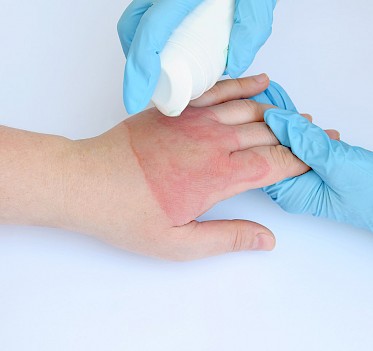Burn Safety at HealthCARE Express
Close to half a million people go to the emergency department every year with burn injuries. Burns are damage to the skin caused by heat, chemicals, electricity, radiation, or the sun. Most burns happen accidentally. At HealthCARE Express, we can help determine the severity, or degree, of a burn based on the depth of the burn and the amount of affected skin. Burns can be painful and left untreated, a burn can lead to serious infection.
What are the classifications of burns? Burns are classified as first-, second-, third-degree, or fourth-degree depending on how deeply and severely they penetrate the skin's surface.
First-degree (superficial) burns.
First-degree burns affect only the outer layer of skin, the epidermis. The burn site is red, painful, dry, and with no blisters. Mild sunburn is an example. Long-term tissue damage is rare and often consists of an increase or decrease in skin color.
Second-degree (partial thickness) burns.
Second-degree burns involve the epidermis and part of the lower layer of skin, the dermis. The burn site looks red, blistered, and may be swollen and painful.
Third-degree (full thickness) burns.
Third-degree burns destroy the epidermis and dermis. They may go into the innermost layer of skin, the subcutaneous tissue. The burn site may look white or blackened and charred.
Fourth-degree burns.
Fourth-degree burns go through both layers of the skin and underlying tissue as well as deeper tissue, involving muscle and bone. There is no feeling in the area since the nerve endings are destroyed.
How to prevent burns
Be “alarmed.”
Install and maintain smoke alarms in your home—on every floor and near all rooms family members sleep in. Test your smoke alarms once a month to make sure they are working properly. Use long-life batteries when possible.
Have an escape plan.
Create and practice a family fire escape plan and involve kids in the planning. Make sure everyone knows at least two ways out of every room and identify a central meeting place outside.
Cook with care.
Use safe cooking practices, such as never leaving food unattended on the stove. Also, supervise or restrict children’s use of stoves, ovens, and especially microwaves.
Check water heater temperature.
Set your water heater’s thermostat to 120 degrees Fahrenheit or lower. Infants and small children may not be able to get away from water that may be too hot and maintaining a constant thermostat setting can help control the water temperature throughout your home.
Burns can be serious and all but the most minor should be evaluated by a healthcare professional. Visit a HealthCARE Express location near you and our knowledgeable provider can assess your situation and provide burn care if needed.
